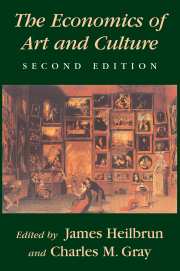Book contents
- Frontmatter
- Contents
- List of figures and tables
- Preface
- Part I The arts sector: Size, growth, and audiences
- Part II The microeconomics of demand and supply
- Part III The fine arts and museums
- Part IV Public policy toward the arts
- Part V Art, economy, and society
- 14 The arts as a profession: Education, training, and employment
- 15 The role of the arts in a local economy
- 16 The mass media, public broadcasting, and the cultivation of taste
- 17 Conclusion: Innovation, arts education, and the future of art and culture in the United States
- Index
17 - Conclusion: Innovation, arts education, and the future of art and culture in the United States
Published online by Cambridge University Press: 05 September 2012
- Frontmatter
- Contents
- List of figures and tables
- Preface
- Part I The arts sector: Size, growth, and audiences
- Part II The microeconomics of demand and supply
- Part III The fine arts and museums
- Part IV Public policy toward the arts
- Part V Art, economy, and society
- 14 The arts as a profession: Education, training, and employment
- 15 The role of the arts in a local economy
- 16 The mass media, public broadcasting, and the cultivation of taste
- 17 Conclusion: Innovation, arts education, and the future of art and culture in the United States
- Index
Summary
It has been a theme of this book that the arts with which it deals – and especially the live performing arts – must compete for the consumer's attention with a popular culture that is powerfully propagated by the mass media of radio, television, the movies, and the culture of advertising and promotion in which they are enmeshed. In the face of that competition, the arts have not fared badly.
We demonstrated in Chapter 2 that there was a measurable arts boom in the 1970s and that growth continued into the 1980s, but with increasing signs of weakness in some sectors, especially after the middle of that decade. In Chapter 13 we showed that the early 1990s brought sharp reductions by some states and localities in the level of government support for the arts. Federal support through the NEA was slashed from $162 million in 1995 to $99 million in 1996. These cutbacks, coupled with the apparent slowdown in the growth of arts audiences, put many arts institutions in financial jeopardy. Were these merely troubles of the moment, or was the long-run trend now running against the arts? Understandably, there was a great deal of anxiety in the art world about the answer to that question.
It is always risky simply to extrapolate into the future from recent experience. It may be worthwhile, nevertheless, to consider the situation of the arts sector by sector in order to reason out what we think the future may bring.
- Type
- Chapter
- Information
- The Economics of Art and Culture , pp. 385 - 402Publisher: Cambridge University PressPrint publication year: 2001



